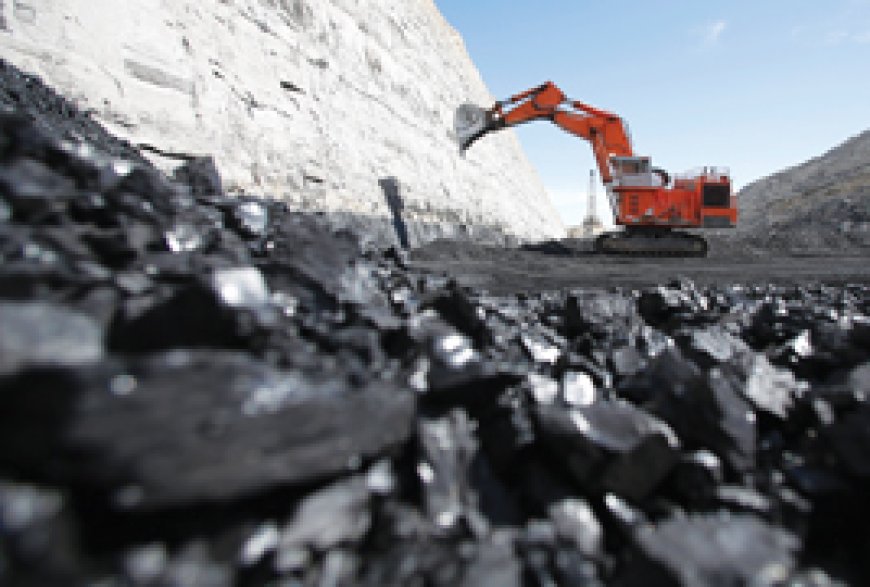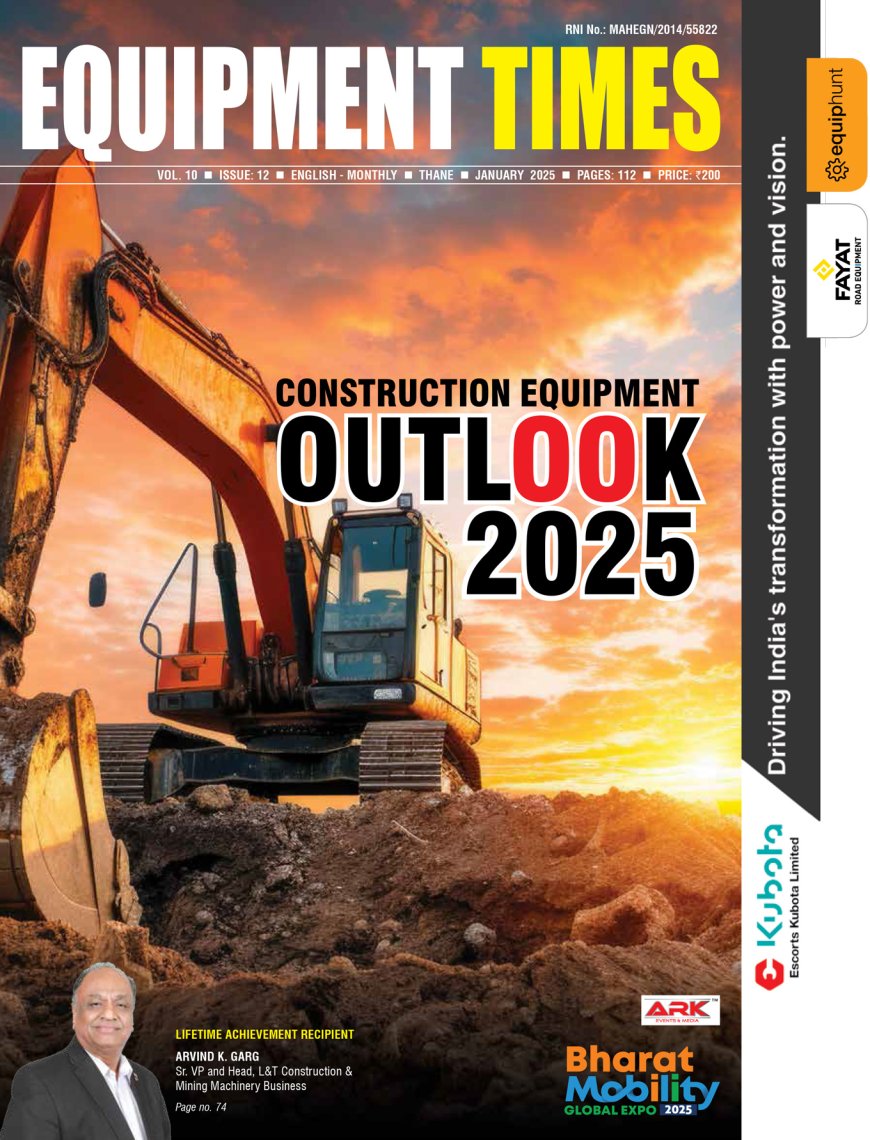Mining Potential
FDI upto 100% under automatic route, introduction of the MDO contracts with longer duration, which calls for bigger size and bigger capacity equipment, coupled with many other policy initiatives, mining sector is expected to up the demand for mining equipment

FDI upto 100% under automatic route, introduction of the MDO contracts with longer duration, which calls for bigger size and bigger capacity equipment, coupled with many other policy initiatives, mining sector is expected to up the demand for mining equipment in the long run.
According to industry input the coal sector is expected to grow by around 6-7% year on year basis, the despatches of coal has also started showing signs of improvement, which will result in increase of coal production. As regards mineral mining, though trends are positive, growth levels are lower as compared to coal. There has been increase in the enquiry level from the mining sector for heavy earthmoving equipment and machinery for eg. Coal India has announced a budget of Rs 7000 crore plus on the Capex. There are MDO’s and other several other contracts, which have started exploring the investment on the CAPEX for the mining operations. Some of the Coal India subsidiary companies have also started purchase of equipment. Singareni Collieres bought 10cum, 15 cum excavators, 60T/100T dumpers, wheel loaders etc. PSU’s have a high potential of buying equipment like excavators, dumpers, wheel loaders etc and these purchases are normally bundled with maintenance contract packages. Private players play an active role in over burden removal contracts, and most of them are currently in the buying cycle.
Mining is one of the core sectors that drive growth in an economy. Not only does it contribute to GDP, it also acts as a catalyst for the growth of other core industries like power, steel, cement, etc., which, in turn, are critical for the overall development of the economy. According to one of the analysis by Federation of Indian Chambers of Commerce & Industry (FICCI) every one percent increment in the growth rate of mining and quarrying results in 1.2 – 1.4% increment in the growth rate of industrial production and correspondingly, an approximate increment of 0.3 percent in the growth rate of India’s GDP.
The Ministry of Mines, Government of India, has targeted significantly higher share of GDP from mining – from then existing 2% of GDP to 5% of GDP over the next 20 years. That required mining to grow at 10-12% per annum and called for the use modern mining technology and advanced equipment. That also made it imperative to a gradual shift towards greater application of continuous mining systems, larger sized equipment and greater energy efficient systems, and not to mention the critical role automation and IoT were expected to bring a spectacular change in mining space.
India is a major producer of minerals and ores, and important among them are mica, coal, barite, bauxite, iron ore, zinc, manganese and aluminium. However, coal sector is the main driver for growth in demand for mining equipment. Production of coal and lignite has increased significantly in the last decade from 462.1 million tonnes in year ended March 2007 to 683 million tonnes in 2016 and a target of was 724.7 million tonnes in 2017 and one billion tonnes by 2019.
Further, the mining sector is closely linked to infrastructure development, which in turn has a major influence on the overall economy and prosperity of the country. Therefore in the long term, the coal, steel and cement sectors should see positive trends, which supports growth in mining activity and equipment demand.
Underground Mining
India is the world’s third largest producer of coal and has the fifth-largest reserves globally. During 2001-02, open cast mining contributed to 82% and underground mining contributed to 18%. During 2014-15, open cast mining was approximately 91% and underground mining was 9%. Underground mining in India has not been developed due to lack of new underground technologies. SCCL has commenced production from the first of its kind in India, Long wall technology in Adriyala Shaft Project in 2014 with a rated capacity of 2.81 MTPA capacity imbibing International Standards. It has around 47 mines, of which 16 are opencast mines and 31 are underground mines. In order to achieve the target of 100 mt by 2020, SCCL is planning to start 20-25 new mines in the near future.
Since 2011, the exports of processing equipment are reduced by 1/3 up to now. It is not probable that the need for processing and beneficiation of minerals is reduced in the same scale. Beside this fact, it is amazing that no extraction technology has been exported to India for years. In this respect it is of importance that there are not so many underground operations in India but the need for mechanization of underground mining is still essential.
MDO Impact
MDO contracts, being long term in nature, involves high volumes of production to be handled, which calls for upsizing of the HEMM, as compared to standard contracts. Cost per ton of excavation depends on the efficiency and effectiveness of the fleet of equipment used. Given this background, it is expected that customers executing wuch contracts will demand large size excavators, dumpers, etc. Technology will play a key role in the equipment used in MDO contracts. Usage of electric excavators can be explored for any MDO having a captive power plants which will reduce the operating cost of the excavators; usage of AC drive dumpers can give a better operating cost and more uptime resulting higher utilizations; and fleet management system to monitor and coordinate between excavators and dumpers so as to make best utilization of the operating fleets.
The MDO concept is the future of the mining industry in India and will bring more efficiency in mining operations. The MDO approach is well known and popular in many mineral rich countries and even established companies participate under this mechanism. These contract mining companies are specialised in mining operations. They provide ample scope for maintaining heavy and expensive machineries and provide time for training the staff as the coal sector is cyclical and vulnerable to changes in demands.
In the future the Coal Ministry is looking to offer more coal blocks with large reserves to MDOs. This is the right step towards production enhancement. Most importantly their presence will not hinder the growth of the private sector as they can continue with captive mining. The hiring of MDOs along with speedy development of the coal evacuation infrastructure is the way forward for the coal industry. In order to meet the coal demand of the country Coal India Limited (CIL) has also decided to implement some of its mine/projects through the Mine Developer and Operator (MDO) route. At present 54% of the total production is achieved through MDO Route.
Industry Trends
The mining sector has seen Capex investments at the PSU level and this has translated into new machine purchases as well as the development of mining infrastructure. This is part of the drive to reach an annual coal production target of 1 billion tonnes per annum by 2020. There is private investment as well in the iron ore sector that is creating a bit of interest. For the limestone market, the industry is witnessing more activity with companies adding new machines to give them additional capacity or to replace older units.
With huge investments expected in coal sector, and also in mineral benefaction, the demand for bulk material handling systems is expected to be huge. Opening up of new mines will also boost the demand. The growth of bulk material handling segment solely depending on these verticals has also been adversely impacted. It also depends on how the overall GDP growth takes place. The governments forward looking policies will have major role to play in the growth of the BMH segment.
Machine Split-Up
It is very difficult to segregate equipment for exclusive usage in mining. However, major equipment used for mining applications in the country are dump trucks, large excavators, crawler dozers, mobile compressors and wheeled loaders. Off-Highway Research sheds light on the demand-supply scenario for a variety of major earthmoving equipment in the mining sector.
Crawler Excavators: A large proportion of 20T and above crawler excavators is used for mining and quarrying applications, which constituted over 40 per cent of total market of 16,492 units in 2016. Off-Highway Research forecasts the market to grow 20 per cent to 20,000 units in 2017 and reach 30,000 units by the 2021 with a CAGR of 12-13 per cent.
Crawler Dozers of over 300 hp are generally used for mining applications and constituted 43 per cent of the total sales of 435 units in 2016. The market is predicted to grow significantly and remain in the range of 600-700 units during 2017-2021 due to demand from construction as well as mining sectors.
Articulated Dump Trucks: The overall market for articulated dump trucks in the country is very small. In the past most these were sold to iron ore mines in Goa. This has a niche market and there have been no sales after 2013, and future sales will continue to remain insignificant.
Rigid Dump Trucks: Typically, rigid dump trucks are almost exclusively used for mining, except for a very limited use in large hydro electric projects. Its demand witnessed a big decline 36 per cent to 343 units in 2016 due to delay in new projects implementation. Coal sector is the sales driver and accounts for nearly 75 per cent market, which is projected to grow to 450 units in 2017, and reach the level of 700 by 2021.
Motor Graders: The motor grader market peaked at 888 units in 2016. However, the machine usage for haul road maintenance in quarries and mines is limited to only 5-6 per cent of total sales. The machines operating in the country (construction and mining) range from the smallest 11T models with engines of 135 hp, to those weighing nearly 60T with over 500hp engines.
Wheeled Loaders: The quarry and mining applications of wheeled loaders include re-handling of material for wagon/truck loading at mines, railway yards and crusher sites and also along with surface miners, but are very seldom used on the mine face directly. The wheeled loader market was 2,206 units in 2016 with over 65 per cent usage in mining. Off Highway Research forecasts a 13 per cent growth in wheeled loader sales in 2017, which will be followed by a steady but moderate increase in subsequent years to peak at 3,400 units by 2021.
Mobile Compressors market was 4,678 units in 2016 of which around 37 per cent were bought for quarrying and mining application. It is projected to decline to 4,500 units in 2017, however, but the long term forecast remains positive and sales are expected to peak at 5,500 units in 2021.
Industrie 4.0
VDMA considers Industrie 4.0 of vital importance in the long term, not only to the mining equipment manufacturers but also to German engineering as a whole. Industrie 4.0 allows increase in productivity together with a minimization of personnel costs. Furthermore German manufacturers and VDMA Mining do a lot to keep a leading position in mining technology, especially in underground mining. In order to maintain their leading position, particularly in the underground mining sector, German manufacturers have been involved with Industry 4.0. The industry presented the first machinery to mine coal or other material entirely independently and autonomously in early 2010, and in global comparison is at the forefront of modernising its own production facilities.
Growth Opportunities
An estimated 1800 units of earthmoving equipment was sold to the mining and quarry segment in FY 2015; of which 86% were excavators and dumpers. It is estimated that the market for earthmoving equipment in the mining segment will grow in FY 2017 to touch 2080 units. The market in mining segment is valued at approximately US$ 0.47 billion, 56% of the market by value, is constituted by dumpers and 34% by excavators.
The demand for mining equipment grew by over 35% during 2016, overcoming four consecutive years of weak demand, giving a boost to the sector which is likely to grow by 13-17% in 2017. The industry growth this year has been somewhat curtailed despite strong growth during January-February 2017 as the markets were temporarily hit by emission related ambiguity and GST during April and July 2017, respectively. It is expected that the sector’s growth to lower in 2018 with it growing by 8-10%. For 2019, industry growth may slow down to around 4 % due to Union elections and high base effects.
Need Better Inflow of FDI
India is in dire need of foreign investment to boost growth in various sectors particularly in mining and metals, infrastructure and construction. To achieve this, the government has been opening up various sectors for foreign direct investment (FDI), since the last few years. Under the Mines and Minerals (Development and Regulation) Act of 1957, FDI upto 100% under automatic route is allowed for the mining and exploration of metal and non- metal ores including diamond, gold, silver and precious ores. Cumulative FDI inflows into the mining sector between April 2000 and June 2017 stood at US$ 2.228 billion as per Department of Industrial Policy and Promotion (DIPP).
There has been a lot of volatility in the annual FDI flows in mining during the period under consideration i.e. 2000-01 to 2016-17. The amount of FDI in Mining was maximum at $ 684.39 million in 2014-15. It increased by $ 671.66 million as compared to 2013-14, and held a share of 2.21% in total FDI in India, during that period. The amount of FDI in mining decreased by $ 464.92 million and was at $ 55.75 million in 2016-17, as compared to 2015-16. In percentage terms, the decrease was -89.29%. The share of FDI in mining in total FDI in India was 0.13% in
2016-17.”
According to the industry inputs current shrinkage in the FDI inflow is attributed to hurdles in policy documentation and bureaucratic clearance associated with FDI for the mining sector. However, the perspective on a long term is quite positive.
The Way Forward
While the trends towards greater application of continuous mining systems, larger sized equipment and greater energy efficient systems are sure to continue, automation is likely to become a more spectacular change in India in medium term. It may be anticipated that demand for mining’s industrial Internet of Things, and new simulation and optimization software will influence the industry in India and that the use of remotely-controlled equipment will be the most important development over the next 5-10 years.
There is very strong scope for automation in mining. It delivers more environmentally friendly operations through improved productivity. Using intelligent machinery to manage duty-cycle work means energy usage is optimized. More recently we have seen the pace of development increase, particularly with advances in technology and the IoT.
The industry believes the opening up of mineral deposits for FDI will have a very positive impact on the mining business in India. It will attract the brightest and best, and benefit the mining industry as a whole. There’s already a strong focus on maximizing cost-per-tonne of production in the Indian coal industry, but this incorporation of the private sector into the business will see a much stronger push to productivity. Mining operators know they need to get maximum efficiency from their operations, but now they also need to combine that with maximum capacity. There is an ongoing focus on energy-efficient equipment in the mining sector in India; and the prospects are very good for machinery in the mining sector.
Hits: 106










